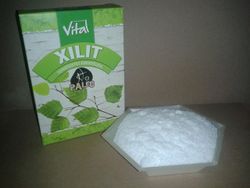Xylitol
 Store-grade xylitol
| |
| Names | |
|---|---|
| IUPAC name
(2R,4S)-Pentane-1,2,3,4,5-pentol
| |
| Other names
1,2,3,4,5-Pentahydroxypentane
Xylite | |
| Identifiers | |
| Jmol-3D images | Image |
| |
| Properties | |
| C5H12O5 | |
| Molar mass | 152.15 g/mol |
| Appearance | White crystalline solid |
| Density | 1.52 g/cm3 |
| Melting point | 92–96 °C (198–205 °F; 365–369 K) |
| Boiling point | 345.39 °C (653.70 °F; 618.54 K) |
| 200 g/100 ml (25 °C) | |
| Solubility | Soluble in ethanol, methanol, pyridine, tetrahydrofuran Insoluble in diethyl ether, benzene, chloroform |
| Solubility in ethanol | 1.2 g/100ml |
| Solubility in methanol | 6 g/100ml |
| Vapor pressure | ~0 mmHg |
| Thermochemistry | |
| Std enthalpy of
formation (ΔfH |
1,100.99 kJ/mol[1] |
| Hazards | |
| Safety data sheet | Fischer Scientific |
| Related compounds | |
| Related compounds
|
Arabitol Ribitol |
| Except where otherwise noted, data are given for materials in their standard state (at 25 °C [77 °F], 100 kPa). | |
| Infobox references | |
Xylitol is a sugar alcohol used as a sweetener. It has the chemical formula C5H12O5.
Contents
[hide]Properties
Chemical
Xylitol will react with nitric acid to yield xylitol nitrates.
Physical
Xylitol is a white crystalline solid, with a sweet taste similar to that of sugar, though it has a slight fruity flavor. It is soluble in water (200 g/100 ml at 25 °C)[2], methanol (6 g/100 ml), ethanol (1.2 g/100 ml) and pyridine. It is insoluble in ether.[3] Its melting point is between 92 to 96 °C, and the boiling point has been determined to be 345.39 °C. Xylitol has a density of 1.52 g/cm3.
Availability
Xylitol is available in most hypermarkets and health food stores, usually as 99-99.9% pure. The price depends on the brand.
Preparation
Xylitol can be extracted from various fruits, though this process is intensive and is much cheaper to just buy it from stores.
It can also be prepared through the hydrolysis of xylan, a polysaccharide found in wood. This gives xylose, which can be reduced to xylitol.
Projects
- Sugar substitute
- Make xylitol pentanitrate
Handling
Safety
Xylitol has no known toxicity or carcinogenicity, and is considered safe by the FDA. It has an extremely low glycemic index of 7 (glucose GI is 100) and has been shown to be useful in reducing tooth cavities. Xylitol does however have laxative effects, though it's possible to build up resistance after several weeks of consuming it.
Xylitol however may be fatal to dogs and birds.
Storage
In closed containers.
Disposal
Xylitol does not pose any danger to the environment and can be poured down the drain or dumped in the soil or trash.
References
- Jump up ↑ Tewari, Yadu B.; Goldberg, Robert N.; Journal of Chemical Thermodynamics; vol. 28; nb. 10; (1996); p. 1127 - 1144
- Jump up ↑ Bakery Products: Science and Technology, Y. H. Hui, 2006, pag. 32
- Jump up ↑ http://www.scbt.com/datasheet-280193-xylitol.html
Relevant Sciencemadness threads
- Chemical pages without CAS Registry Number
- Articles without EBI source
- Chemical pages without ChemSpiderID
- Chemical pages without DrugBank identifier
- Articles without KEGG source
- Articles without InChI source
- Articles without UNII source
- Articles containing unverified chemical infoboxes
- Chemical compounds
- Organic compounds
- Biologically-derived compounds
- Alcohols
- Polyols
- Sugar alcohols
- Readily available chemicals
- Materials available as food grade
- Edible chemicals